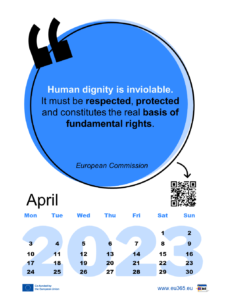YOU’RE WELCOME!
 Learners will be able…
Learners will be able…
… to respect and value each other’s differences and the power of inclusion.
You need:
- 60 minutes
- Tutor and at least 15 learners
- Computers, papers and pencils
Instructions (Step-by-Step)
- The activity will begin by explaining to the group that they are going to talk about forced mobility:
- Children and families being displaced from their homes and countries of birth. The tutor will explain that throughout history, people have moved from their places of birth for different reasons. Today, situations such as natural disasters or armed conflicts are forcing millions of people to leave their homes to survive. This situation particularly affects women and girls, who are exposed to situations of violence and inequality. The tutor can also show learners relevant videos.
- The tutor will then open a class discussion:
- Can you imagine having to leave your home? How do you think you would feel?
- How would you like to be received and welcomed in the place you are moving to?
- Then, in order to reflect on how people feel in places of refuge, the tutor will carry out an empathy exercise. The tutor will randomly select 3 members of the group, who will leave the class for a few minutes.
- The tutor will then divide the rest of the class into three groups, each of which will be asked to do an activity, which will be joined by one of the 3 “outsiders”, the learners who are outside the class.
-
- Group 1 will be instructed to actively exclude the outsider who arrives for the activity, without explaining it to them or allowing them to participate.
- Group 2 will ignore their outsider and do as if they weren’t there at all.
- Group 3 will make their outsider feel welcome by stopping to explain the activity and inviting them to actively participate in it.
- The outsiders will rotate between the groups, spending two minutes in each group.
- At the end of this exercise, the tutor will lead a group discussion…
- How did the volunteers feel and how did the different groups feel?
- What is the difference between welcoming and not welcoming?
- Given the situation of forced mobility we are discussing today, which of the three models would we like to promote as a group?
- How would we like to welcome and be welcomed?
- How can we promote a culture of welcome in our environment?
Post Views: 939
